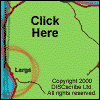
|
The Battle of Largs: October 1, 1263
Since 1098, the islands of Western Scotland (the Hebrides) and portions of Kintyre and Argyle had been under the complete control of the Norwegians. This was the result of a treaty between Edgar, who was King of Scots and Magnus Barefoot, King of Norway. But the Norwegians, although the most powerful force in the region, seemed content with allowing the area to govern itself, which was demonstrated with the rise of Somerled (a man of Dalriadan or Scotti descent) to power as King of the Isles during the twelfth century. As long as the islands were subservient to Norway and paid their taxes, the Kings of Norway seemed content with the arrangement. But the populace was generally of Scotti and Pictish origin, and resented their Viking masters. They quite naturally wished to align themselves with Scotland, or have a kingdom of their own, but there was the problem of the powerful Viking army. In 1263, a series of events took place, which gave this opportunity to the natives of the Isles.
Alexander was a man of peace, and attempted to resolve the situation diplomatically. He promptly offered to buy the islands and territory from the Norwegians. But King Hakon was already enraged by the turn of events and raids on territory that had remained loyal to him. Hakon quickly sailed with the army he had been assembling for war in Ireland to recover the territory lost. As he reached the Isles, King Hakon stopped at every island, subduing the populace and swelling the size of his army. He continued throughout the lost territory until it came time to land in Scotland itself. By this time, the fleet of King Hakon was quite large, numbering over 200 ships full of soldiers. The Scots, who had heard of the Norwegian Army's approach, were assembling near the town of Largs. These men consisted mainly of a cavalry of 1500 noblemen or knights, whose ranks were being swollen daily by common men carrying spears or bows and arrows. Their leader, was Alexander III, the King himself, who was surrounded by many more men who were quite famous in the history of Scotland; these included Alexander Stewart (4th High Stewart of Scotland), Robert Boyd, and many others.
On approximately October 1st, 1263, the Scots got the opportunity they had been waiting for. The Vikings landed a force at Largs, which was to be a beachhead for the landing of the remainder of the Viking force. A large storm blew up, which prevented the landing of further troops, while sinking many Viking ships outright. It was at this time, the Scots under Alexander chose to reveal their position. The main Scottish force took the high ground above the town of Largs and in response the Vikings attacked with half their force ashore. The other half remained at Largs to allow further reinforcement. The Scottish advantage of ground carried the battle, as eventually the Scots pushed down the slope and into the town itself, thereby forcing the remaining and greatly outnumbered Vikings ashore to attempt to reach their ships. The combination of the storm and the battle proved to be too much for the vastly superior Viking force. The wounded King Hakon was forced to retreat with what was left of his army. King Hakon never reached home in Norway, as ships from the Isles, which now had no reason to fear or submit to him, harassed his remaining fleet. He died in Orkney at the end of 1263. By 1266, King Hakon's successor, Magnus IV, negotiated the treaty of Perth, which returned the Isles and Kintyre to Scotland 400 years after their loss to the Vikings.
by Brian Workman, May 2000 Links: Decline of the PictsKing Alexander III and the Battle of Largs |
Thursday, December 26th, 2019
Attention visitors: Tartans.com is back. Please note that this is a snapshot of the site as it existed nearly 20 years ago and you may encounter broken links; we are still combing through the site and correcting those as we find them. Please also note that some sections are currently not functional, primarily the discussion forums/clan chat boards.
|
** HOME - First Time Visitors - Glossary - - Contact Us ** Awards | Bibliography | Clan Calendar | Clan Chat | Clan Finder | History | Famous Scots | Genealogy | Great Hall of the Clans | Links | News and Features | Scots on the Net | Search | Site Map The Gathering of the Clans
Copyright 1995- Tartans.com - All Rights Reserved. |



